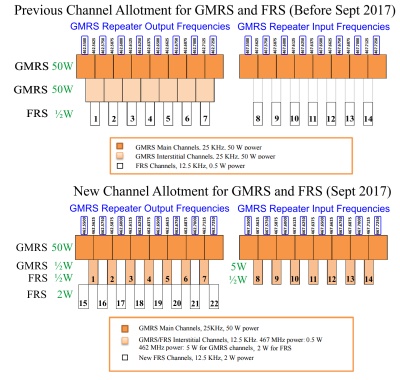|
|
Changes to Part 95 Rules Affecting GMRS/FRS (Sept 2017)
Reference Part 95 Rules (html) Reform doc (incl Part 95 Rules) as PDF

The FCC implemented several changes to the Part 95 rules impacting GMRS/FRS channels and power levels, apparently to address the problem of commercial GMRS/FRS radio packaging and weak compliance with GMRS licensing rules. (They also dropped several CB laws. For example, CB DXing will now be OK!)
In our humble opinion, as a result of these changes, GMRS users step backwards and FRS users step forward. Here's the 2017 announcement of the Personal Radio Service Reform as published in the Federal Register on September 28, 2017. The Part 95 Reforms, covering FRS and GMRS start here. You can also download the whole enchilada (a discussion of the reforms, as well as the complete revised Part 95 Rules) as a PDF.
The graphic shown to the right (click for larger view) gives my own take on the changes, as they impact the channel assignments and new allowed power levels. I combined the before/after graphics from the Report and Order, clarified them a bit, and added some additional helpful labels.
The positive changes, from a GMRS viewpoint:
- The 467 MHz Interstitial frequencies (formerly exclusive to FRS) are added for GMRS handheld units (with rubber-duck antennas), although limited to 1/2 watt, bandwidth of 12.5 kHz.
- Brief, infrequent, and manually initiated digital data transmissions (e.g., APRS position reports and text messages) are now permitted from handheld units in either GMRS or FRS on 462 MHz channels.
- Applications for NEW combination GMRS/FRS radios will no longer be accepted (after the first 90 days of this revision). Since all 22 channels available to existing GMRS/FRS radios will now be legal FRS channels, all these old walkie-talkie units will effectively become "FRS radios."
- The antenna height restriction is eliminated for GMRS base station antennas (formerly 20 feet maximum).
The negative changes, from a GMRS viewpoint:
- GMRS users of the 462 MHz interstitial frequencies are now limited to 5 watts (previously 50W!), and still share them with FRS users, who can now transmit up to 2 watts (previously 1/2 watt). At least GMRS users are still allowed twice the deviation (i.e., volume level) of FRS users.
- GMRS users of the newly permitted 467 MHz interstitial frequencies can only use handheld units transmitting up to 1/2 watt. Base and mobile stations—not allowed. As for all interstitial frequencies, these are shared with FRS users, who are also limited to only 1/2 watt on these channels.
- The only exclusively GMRS frequencies are now the repeater input frequencies (aka "467 MHz main channels"). All other "channels" are now shared with FRS: all the 462 MHz frequencies (channels 1-7, 15-22) at 2 watts (up from 1/2 watt), and the 467 MHz interstitial frequencies (FRS channels 8-12), limited to 1/2 watt. A glimmer of light here is that GMRS repeaters can output up to 50 watts on the "462 MHz main channels" shared with FRS (channels 15-22, limited to 2 watts).
You may see other positives and negatives. Again, as I see it: for FRS users, there are several reasons to cheer. GMRS users—not so much.
John AC5JC
Disclaimer: The views, interpretations, and opinions expressed here are those of the author(s) and do not necessarily reflect the official policy or position of any agency of the U.S. government.
|
|


